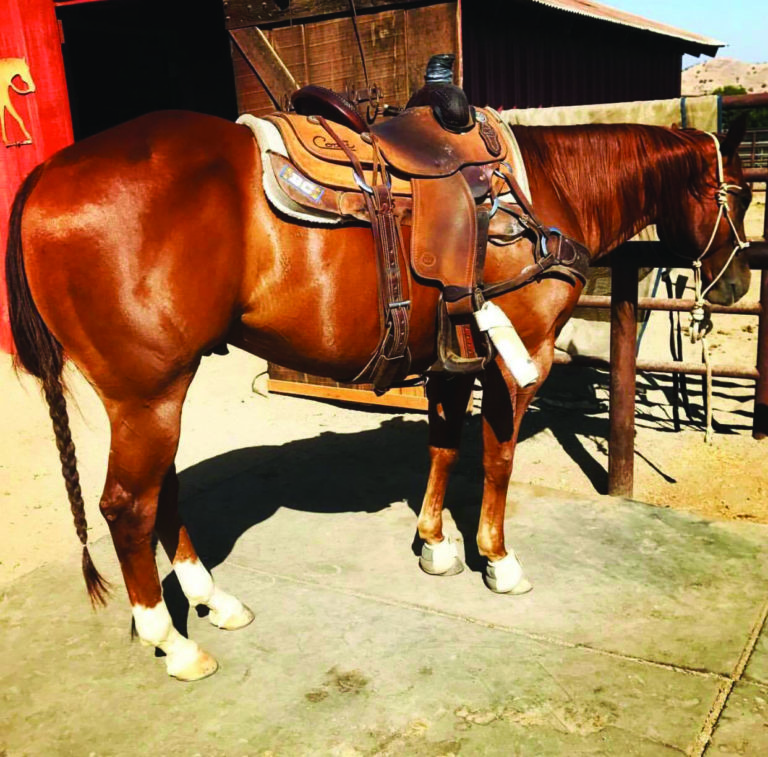Obviously, you need the right tree to keep your horse working, but it doesn’t do you much good if the saddle doesn’t fit you, too. Like trees, these components can also get complicated.
One thing to keep in mind–women’s upper legs tend to be longer than their lower, so their center of gravity is further forward and their feet can get behind them easier when roping. So stirrups blocked forward are a consideration. Also, a female’s gluteus muscles are higher than a man’s, meaning a higher cantle height might be in order. Finally, more seat padding is great because getting more of a push from behind can prevent women from sitting back too much because of the size and shape of their gluteus muscles and the length of their tailbones.
Double J’s popular High-Tech Roper has a couple of new technologies designed for both rider and horse fit–the Adjustable Fender Hanger and 3-Way Adjustable Rigging.
“On a level-backed horse, your stirrups feel comfortable and you’re balanced when you stand up to rope, because you have them adjusted to your body build,” said general manager Jesse DeBord, a team roper whose father founded the company. “However, put that saddle on a horse that runs downhill, and when you stand up, your feet go behind you. Now, you can adjust the fenders more forward and you can counteract that.”
Joe Peterson said 3 Forks Saddlery used to block their fenders to reduce movement, especially to the rear. Lately, more of their customers have been older or more amateur and enjoy sitting back, so they don’t mind a more forward stirrup and they also prefer comfort to performance in their ground seat.
“One thing I really like about our in-skirt rigging and adjustable stirrup combination is what you can do if, say, you’re training a green head horse to leave out of the hole with his shoulders up, working on his hind end,” said DeBord. “I used to slide my left fender all the way to the front and the right one all the way to the back. Now when I approach the steer, it’s like roping the dummy with my right shoulder further back so I have more range and power. Plus, I can better use my left foot to pick up that horse’s shoulder because my right foot is further back on the ribcage.”
There’s some conflicting opinions about whether rigging placement affects saddle balance. Usually the “rigging” or billets–rings from which your cinch hangs–are near your fenders and can interfere with leg movement.
Double J Saddles come with the traditional Double D rigging or an in-skirt, three-way adjustable rigging, which they say tests stronger and eliminates the bulk that can interfere with the movement of your leg. DeBord says it’s designed because horses’ shoulders tie into their skeletons in different positions, depending on conformation. The rigging’s forward position helps keep a saddle from sliding forward, he says, while the rear position keeps it from sliding back, and using both centers triangulates the pressure to distribute it more evenly.
A traditional rigging hangs basically directly under the swell of your saddle, or straight off the front of the bars of the tree. Peterson of 3 Forks prefers this “full” rigging placing your cinch directly under the billets so the saddle isn’t pulled forward.
“We simply don’t want a saddle pulled up onto the shoulders,” he said. “The most surface area of the tree is in front, so it makes sense to use the full position, centered under the swell. You’re pulling down on the greatest surface area of the tree.”
To DeBord, that works fine if the saddle fits. If not, it’s akin to sucking those bars in tight right behind the shoulder.
“I feel like it would be like us trying to throw a football while somebody has an elbow thrown behind our shoulder blade,” he said.
Larry Coats, however, said rigging placement has nothing to do with saddle fit. His rigging sets back about a half-inch from full, in the 7/8 position, just to keep the cinch out of the horse’s elbows.
“If a saddle doesn’t fit, it’s going to move around regardless of the rigging placement,” he said. “The tree is what determines whether a saddle stays put.”








